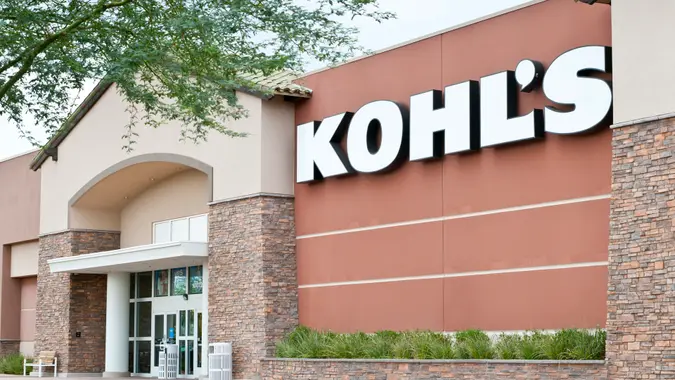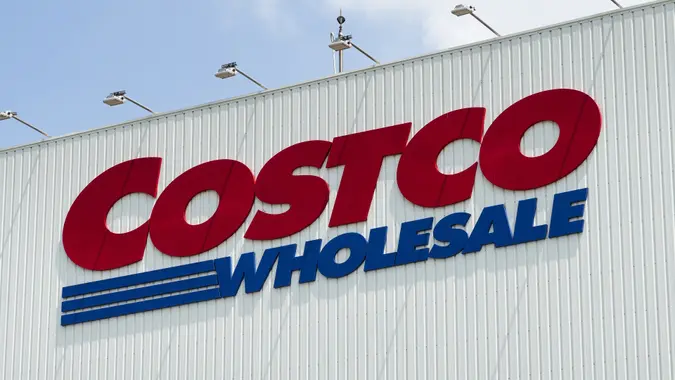We Compared Grocery Bills Across 3 Chains — Here’s Where Shoppers Save the Most

Commitment to Our Readers
GOBankingRates' editorial team is committed to bringing you unbiased reviews and information. We use data-driven methodologies to evaluate financial products and services - our reviews and ratings are not influenced by advertisers. You can read more about our editorial guidelines and our products and services review methodology.

20 Years
Helping You Live Richer

Reviewed
by Experts

Trusted by
Millions of Readers
Ever wonder if your weekly grocery haul would ring up cheaper across town? If you usually stick with one store, it’s easy to assume you’re already getting the best money-saving deal.
At GOBankingRates, we put that theory to the test by building the same free pickup cart at three popular retailers: Walmart, Target and Aldi.
The totals were closer than you might expect and the “winner” changes depending on what you buy. Let’s dive into how we shopped and compared the prices along with some helpful tips you can use to save on your next grocery order at any of these stores.
How We Shopped (and Kept It Consistent)
To keep the comparison fair, we filled three online pickup carts with 23 everyday items most families buy:
- Gallon of 2% milk
- Cage-free brown eggs (dozen)
- Whole wheat sandwich bread
- Sliced cheese and shredded cheese
- Ground beef (1 pound)
- About 2 pounds of boneless, skinless chicken breast
- A mix of fresh produce (cauliflower, broccoli, cucumber, red onion, apples, strawberries, avocado)
- 12-ounce frozen mixed vegetables bag
- 32-ounce long-grain rice
- Snacks and drinks (granola bars, chips, Gatorade eight-pack, Capri Sun 10-pack, lemonade)
A few things we tried to control during the price test:
- Same or similar brands and sizes. We specifically chose store brands when possible or name brands that could be matched and kept the package sizes to same amount as or as close to what the store offered.
- Like-for-like quantities. For produce and meat sold by weight, we used typical weights so each cart stayed comparable.
- No fees included. Subtotals reflect item prices only (no tax, service fees or tips) since fees can vary based on where you live.
- Noted any differences. In a few cases, Aldi offered organic or “deluxe” versions or sold only bigger portions that what Target and Walmart offered. When that happened, we flagged it so the quality tiers can explain price gaps.
Here’s what the subtotals came to at checkout (before tax and any service fees).
Walmart
- Subtotal: $68.11
Target
- Subtotal: $74.79
Aldi
- Subtotal: $70.89
Here’s a breakdown of how much each item cost at each store and which retailer offered the best price.
| Item | Size/Notes | Walmart ($) | Target ($) | Aldi ($) | Cheapest (by pack) |
| Whole Wheat Bread | 20-ounce loaf | $3.64 | $3.69 | $2.15 | Aldi |
| Lemonade | Walmart/Target: 52 ounces (Simply); Aldi: 64 ounces (organic) | $2.97 | $2.99 | $3.29 | Walmart |
| Capri Sun Juice Pouches | 10 6-ounce pouches | $2.98 | $3.19 | $2.95 | Aldi |
| Gatorade | eight 20-ounce bottles | $7.98 | $7.99 | $8.79 | Walmart |
| Granola Bars | Walmart/Target: Nature Valley 12 count; Aldi: two packs of six bars | $2.97 | $3.29 | $2.49 | Aldi |
| 2% Milk | 1 gallon | $2.67 | $4.89 | $3.35 | Walmart |
| Cage-Free Brown Eggs | 1 dozen | $3.94 | $3.99 | $5.35 | Walmart |
| American Cheese Slices | 16 ounces / 24 slices | $2.48 | $2.59 | $4.35 | Walmart |
| Shredded Cheese | 8 ounces | $1.97 | $1.99 | $2.99 | Walmart |
| Fuji Apples | 3-pound bag | $5.44 | $5.69 | $3.29 | Aldi |
| Cauliflower | Head, each | $2.96 | $3.19 | $3.09 | Walmart |
| Red Onion | Walmart/Target: cost for each; Aldi: cost for two-pound bag | $1.26 | $1.29 | $2.45 | Walmart |
| Broccoli Crowns | Walmart/Target: cost for each; Aldi: cost per pound | $1.83 | $1.99 | $1.99 | Walmart |
| Cucumber | each | $0.72 | $0.79 | $0.75 | Walmart |
| Avocado | each | $0.70 | $0.79 | $0.75 | Walmart |
| Strawberries | 1-pound container | $2.64 | $2.79 | $2.25 | Aldi |
| Frozen Mixed Vegetables | 12 ounces, steamable | $0.98 | $0.99 | $1.09 | Walmart |
| Boneless Skinless Chicken Breast | Cost per pound (Aldi organic; Target ‘final by weight’) | $5.23 | $4.99 | $4.99 | Target, Aldi |
| Ground Beef | Cost per pound (Walmart/Target: 80/20; Aldi: 93% lean) | $6.93 | $6.99 | $7.19 | Walmart |
| Long Grain Rice | Walmart/Target: 32 ounces; Aldi: 3 pounds (48 ounces) | $1.77 | $1.89 | $2.95 | Walmart |
| Potato Chips | 8 ounces (Cape Cod/Original Kettle style) | $3.50 | $3.99 | $1.65 | Aldi |
Note: We used a different type of shredded cheese for Aldi to match the 8-ounce size used at Target and Walmart. We also ordered a 3-pound bag of rice at Aldi (the store’s smallest size), while the other two stores offered a 2-pound bag of rice.
Some key findings:
- Milk was much higher at Target compared to other stores.
- While Walmart surprisingly beat Aldi’s prices with many items, Aldi’s price for fresh apples and some snacks was still much lower than the other two retailers.
- Target seemed to charge the most for produce
- Aldi offered fewer meat options and charged the most for beef and eggs
So Where Can You Save the Most?
Looking solely at the final subtotal prices, Walmart allows you to save the most money out of the three, but it’s not by a huge margin. Walmart tends to be reliable on core staples like milk, eggs, basic cheeses, rice, frozen vegetables, etcetera.
Walmart
This popular retailer often competes aggressively on national-brand beverages and snacks as well. So if your cart leans heavily on those, Walmart is a strong default.
Walmart’s free pick-up service is convenient, but if you add a Walmart+ membership, it won’t save you much on your purchases, but it can save save delivery fees, add free shipping with no order minimum.
Aldi
Aldi shines on produce (especially when in season), everyday private-label staples and a quick in-and-out experience which are perfect if you like streamlined choices and low base prices without couponing. Aldi does have a weekly ad, but you’d need to tailor your shopping list to those items specifically to see more savings.
Target
Even though Target’s prices were the highest on the list, If you prefer specific national brands, like Target’s Good & Gather or want to stack digital offers, this store can still be a solid contender. To get the most savings, you would need to sign up for a free Target Circle membership and use the Target app so you can view and activate offers regularly.
Target Circle members can always save with coupons in the app or even stack those coupons with others but this requires more time, effort and planning overall.
Smart Tips To Save That Work at Any Store
Shopping at stores that give you a good chance to save is a smart move, but it’s often just one piece of your overall strategy to spend less (and hopefully get more) when it comes to buying groceries. Here are some other key tips to help you save no matter which store you choose.
Look at Unit price, Not Just the Sticker
That big, eye-catching price on the shelf is only half the story. The real comparison lives in the unit price (cents per oz, cents per pound or per count) printed on the shelf tag. Two bags of shredded cheese might both be “on sale,” but one could be 24.9 cents per ounce while the other is 31.2 cents per ounce.
The same goes for beverages. A 64-ounce bottle can beat a 52-ounce bottle on a per-ounce basis, even if the total price is slightly higher. Once you make unit price your default, you’ll automatically dodge the most common pricing traps, especially on snacks, dairy and drinks.
Split Your Trip (or Rotate Stores) Without Burning Time
Do your base shop at the store that consistently wins on staples (milk, eggs, rice, cheese, frozen vegetables), then grab produce at the place that tends to run cheaper or fresher that week. If gas or time is tight, rotate instead of splitting. You’ll capture most of the savings with a lot less running around.
Be a Little Flexible
Keep your list flexible. If strawberries are high this week but apples are low, switch your fruit plan. The “what’s cheap now” approach lets you save without rewriting your entire meal plan.
If apples are down and berries are up, build snacks and sides around apples. If chicken is on a great per-pound price, make two chicken-based dinners and freeze a portion.
Keep a Tiny Price Log of Your Top 10 to 15 Items
Keep a small price log (notes on your phone) of the things you buy every single week like your bread, milk, eggs, rice, shredded cheese, coffee, snack bars and two or three produce staples. Jot the regular price and a “good deal” price. When you see that number, you’ll know to stock up. This takes five minutes to build and saves money all year.
Use Free Pickup To Curb Impulse Adds
Impulse buys are fueled by unexpected finds on end caps and seasonal aisles. Ordering for free pickup limits those “oh, that looks fun” moments and makes it easier to stick to the plan. You still get fresh items (you can request substitutions or skip them), but you dodge the cart-filling stroll.
Editor’s note: Pricing and availability may vary depending on location.
More From GOBankingRates
- 5 Luxurious Winter Clothing Items You Can Find at Costco for Less
- 5 Little Luxuries To Buy at Dollar Tree This December
- 4 Low-Risk Accounts Financially Savvy People Trust for Reliable Returns - And How You Can Use Them
- How Middle-Class Earners Are Quietly Becoming Millionaires -- and How You Can, Too
 Written by
Written by  Edited by
Edited by 


























